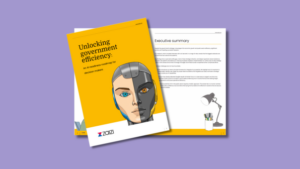
Why digital deliverability must be a key test for policy post-election
In the white heat of an election campaign many things get tested. The fiscal credibility of each party, the potential of their policies to improve lives and the abilities of the party leaders.
All of this matters but as a new government gets to work on its policy agenda from July, one additional test will make the difference between success and failure: the digital deliverability of each policy initiative.
Digital deliverability matters because today data, technology and digital are the machinery of government.
Why digital deliverability matters
The products and services supported by Government Digital Service are used by 13 million people each week and 1,900 public sector organisations. Digital capability and data handling are critical to the functioning and service delivery of every government department, agency or arms-length body.
A new government which is serious about policy delivery has to be serious about understanding the extent to which it is deliverable in this context.
In my time in the civil service, I witnessed an abundance of fantastic ideas which would improve services, save money and make for better, joined-up experiences of government but there were occasions when good work was stymied by a blind spot around its digital deliverability. When there was a failure, it could typically be traced back to five problem areas.
The first of these is a failure to fully appreciate the challenges and context in which people use government services – whether these are internal or external services. This is partly down to misplaced assumptions coming from a lack of diversity in thought, background and life experience. It is also down to a lack of or inadequate user research when a policy idea is fleshed out.
A second problem area is where policy initiatives are developed without full recognition of the dependencies with other departments or agencies which are critical to project success. It is rare now to find a policy initiative whose success will not be influenced by the data, technology, capability and capacity of another team or part of government.
And here policymakers must understand a third potential blocker which is the rarity for teams to work outside of silos to solve problems. Fostering collaboration and a product/long-term mindset requires trust and sense that there is a commitment to a policy being delivered. This is hard to achieve in an environment of constant change.
Importing ‘consumer expectations’ of how a service might work in an environment which is dominated by complexity creates further barriers to deliver was a fourth common issue.
Last of all, a failure to ask questions about deliverability until it is too late or when the true scale of challenges is brought to light through project delivery are a final constraint to success as the required course correction becomes too challenging.
The cost of progressing initiatives which aren’t digitally deliverable shouldn’t be seen solely through a financial lens. The wasted time, political capital and opportunity cost are equally important. So too is the impact this has on end-users who have to live with legacy services which don’t meet their needs and among politicians and civil servants whose risk aversion grows.
New government and new tech
If there is one thing we can safely predict for the new government, it is that the role for tools such as AI, machine learning and automation will grow in the public sector. This means the ability to test policy for digital deliverability will become even greater. To achieve this, there are some simple steps required now:
The first is to support policy teams to understand the technology environment in government and its agencies, the key issues that can constrain delivery – data sharing and ageing infrastructure – and what is required to improve delivery.
The second is to scrutinise policy in the light of these constraints, rooting out assumptions and testing ideas early so the true scope of cost, time and people resource is clearer before a policy idea sees light of day.
In the same way that some of the reporting from the UK Covid-19 Inquiry has exposed how groupthink and a lack of appreciation for how people of different backgrounds undermined policy making, user-led policy design would help improve the digital deliverability of policies.
To make progress on policy delivery, there is a strong case for ensuring senior leaders who understand the role of technology and data in government are able to meaningfully influence policy. The new government might usefully look at the make-up of the ministerial private offices who play a critical role in ensuring policy translated to delivery.
Finally, there is the issue of how we can do a better job of ensuring ministers– newly minted and more experienced ones – understand the opportunities and role of digital in the public sector generally and in public service delivery specifically.
The digital viability of policies is not a mere technicality. It is a fundamental aspect that, if neglected, can compromise the effectiveness and impact of policy initiatives. As the new government sets about its work, embracing a user/digital-first mindset will be indispensable for shaping policies that truly meet the needs of citizens and stand the test of digital deliverability.
Clayton Smith is managing director of Zaizi and formerly, deputy director, digital delivery at the Cabinet Office. To learn more about how to fix the policy-delivery gap download our latest report or get in touch.
-

Modernising government for AI: What key challenges do departments face?
-

PICTFOR roundtable: Is regulation a handbrake or a catalyst to public trust and innovation in AI?
-

Unlocking government efficiency: An AI readiness roadmap for decision makers
-

Beyond blueprints: Making government transformation real
-

How CyberFirst interns shaped Zaizi’s AI training programme
-

AI-First vs AI-Assist: Early-career developer training in the public sector
